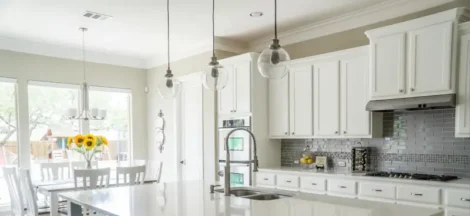Homeownership is both a joy and a responsibility. You have the liberty to customize your living space to your personal preference and create a comfortable environment for your family. However, you must also maintain and enhance your property to preserve its value and guarantee that it remains a safe and pleasant place to live in. The global home improvement market in 2020 was valued at a staggering 763 billion USD. And in 2021, in the US alone, home improvement sales totaled 538 billion USD. With a CAGR of more than 4%, this amount is projected to reach around 620 billion USD by 2025. It is evident from these figures that homeowners are eager to acquire and apply new skills in order to better their homes and the lives they live in them.
Gearing Up for a Complete Home Renovation
One crucial aspect of a renovation is to look for appropriate storage units to house your belongings during the renovation process temporarily. This will prevent damage to your belongings and provide a clutter-free workspace for contractors.
According to a review by the University of California, Los Angeles, American families are overburdened by the sheer quantity of their possessions, resulting in a need for improved storage solutions. But worry no more! There are more than 51,206 self-storage facilities in the United States, including more than 4,000 in California alone. For instance, if you reside in Pacheco, CA, all you have to do is look up Pacheco Storage and you’ll get an abundance of options. Storage units are an excellent option for those requiring additional storage beyond what their homes can provide. These facilities provide various storage unit sizes for different needs, ranging from small personal items to large furniture and vehicles. Some even have 24-hour video surveillance, electronic gate access, and individually-alarmed units so customers can have peace of mind knowing their belongings are secure. With self-storage units, residents can effectively manage their storage needs while maintaining a clutter-free, organized home.
Furthermore, it would be best if you established a realistic budget accounting for materials, labor, and unexpected expenses. Establish a timeline with your contractor and develop contingency plans for any unforeseen delays through proper communication. Remember to consider how the renovation will affect your daily routine and, if necessary, make interim living arrangements.
Home Improvement Tips Every Homeowner Should Know
From simple maintenance tasks to larger renovations, here are 10 home improvement tips to help you save time, money, and effort while making your home more attractive and functional.
Prioritize Home Maintenance
Home maintenance is essential to preserve the value and functionality of your home. By regularly inspecting and addressing minor issues, you can steer clear of larger, costlier problems. According to guidelines of the National Association of Home Builders, you should perform some key maintenance tasks throughout the year, such as cleaning your gutters, inspecting your heating and cooling systems, and evaluating your smoke alarms. Consistent maintenance will save you time and money in the long run.
Create a Home Improvement Budget
A well-structured budget is crucial for managing home improvement expenses. According to a HomeAdvisor survey, the average homeowner in the US spends $9,078 on home improvement projects annually. Therefore, it is wise to list your projects, allocate funds for materials, labor, and contingencies, and monitor your spending throughout the process. By adhering to a budget, it is possible to avoid overspending and complete projects more efficiently.
Invest in Energy Efficiency
Energy efficiency is both cost-effective and environmentally friendly. You can reduce your energy consumption by implementing measures such as insulating your home and installing solar panels. These investments can substantially reduce your utility expenses and contribute to a greener local as well as global future. The US Department of Energy reports that homeowners can reduce their energy bills by 5 to 30% by implementing energy-efficient improvements.
Focus on High-ROI Improvements
When planning home improvement projects, it’s essential to prioritize those with a high return on investment (ROI) to make the most of your time and resources. According to a 2021 report by Remodeling Magazine, projects like minor kitchen remodels and garage door replacements can yield an ROI of over 70%. Keep this in mind when deciding which projects to tackle first.
Know When to DIY and When to Hire Professionals
While some DIY projects can be cost-effective, others are best left to the professionals. According to studies, the return on investment for projects such as electrical work, plumbing, and roofing repairs is greater for homeowners who hire a professional than those who attempt these tasks themselves. Hiring experts further ensures compliance with safety and quality standards. To sum it up, it is important to understand your skillset and recognize when to seek professional assistance.
Acquire Necessary Permits
Obtaining permits demonstrates compliance with local building codes and can prevent potential fines or project delays. Familiarize yourself with the permit-acquiring process to guarantee a smooth, hassle-free home improvement experience. According to a survey by the National Association of the Remodeling Industry, 31% of homeowners are unaware of the permitting process. Non-obtention of permits may result in fines or even forced removal of completed projects.
Prepare for the Unexpected
Unanticipated issues are common during home improvement projects. A HomeAdvisor study revealed that 63% of homeowners encountered unexpected issues during their projects. To mitigate potential setbacks, allocate a contingency budget of 10-20% and keep a margin of extra time for project completion. This way, you can minimize disruptions and keep your projects on track.
Maintain a Safe Work Environment
Safety is of paramount significance when working on home improvement projects. The Consumer Product Safety Commission reveals that over 246,000 people suffered from DIY-related injuries in 2018 alone. Therefore, it is crucial that you ensure you have the necessary safety equipment, such as goggles, gloves, and proper footwear, to keep you and other members of the house safe. Follow manufacturer guidelines for various tools and equipment, and avoid taking shortcuts that could sabotage your safety. By doing so, you can complete your projects with confidence and minimize the risk of accidents.
Choose Quality Materials
Selecting high-quality materials is essential for the longevity and aesthetic appeal of your home improvement projects. Durable materials can withstand wear and tear, reducing the requirement for frequent repairs or replacements. Although it may be tempting to opt for less expensive options, investing in high-quality materials will save you from expenses in the long run and result in a more polished final result. According to a survey by Houzz, 69% of homeowners prioritize durability when selecting materials for their renovations.
Seek Inspiration and Expert Advice
Explore resources such as blogs, magazines, and social media to stay informed on the latest home improvement trends and techniques. A study by Statista found that 42% of US internet users rely on websites and apps for home improvement advice. Networking with professionals and other homeowners can also provide useful insights and tips for your projects. Furthermore, consider consulting with experts for their valuable advice before embarking on major renovations to ensure your plans are well-informed and align with the best practices. By seeking inspiration and expert advice, you can expand your knowledge and enhance the quality of your home improvement endeavors.
Conclusion
Home improvement is a continuous process requiring time, effort, and financial investment. Before starting this journey, ensure that the efforts you plan to make are both cost-effective and beneficial to your home’s value. Remember to choose quality materials, and do not be afraid to seek expert advice when needed. With these tips in hand, you’ll be well-equipped to create a beautiful, functional, and energy-efficient home that you can take comfort in for years to come. Remember that home improvement is not only about aesthetics but also about creating a safe and comfortable environment for you and your family. Happy improving!





 Protecting Your Home from Pests: A Guide to Pest Inspection
Protecting Your Home from Pests: A Guide to Pest Inspection